warning light Alfa Romeo 156 2004 Owner handbook (in English)
[x] Cancel search | Manufacturer: ALFA ROMEO, Model Year: 2004, Model line: 156, Model: Alfa Romeo 156 2004Pages: 357, PDF Size: 5.04 MB
Page 28 of 357
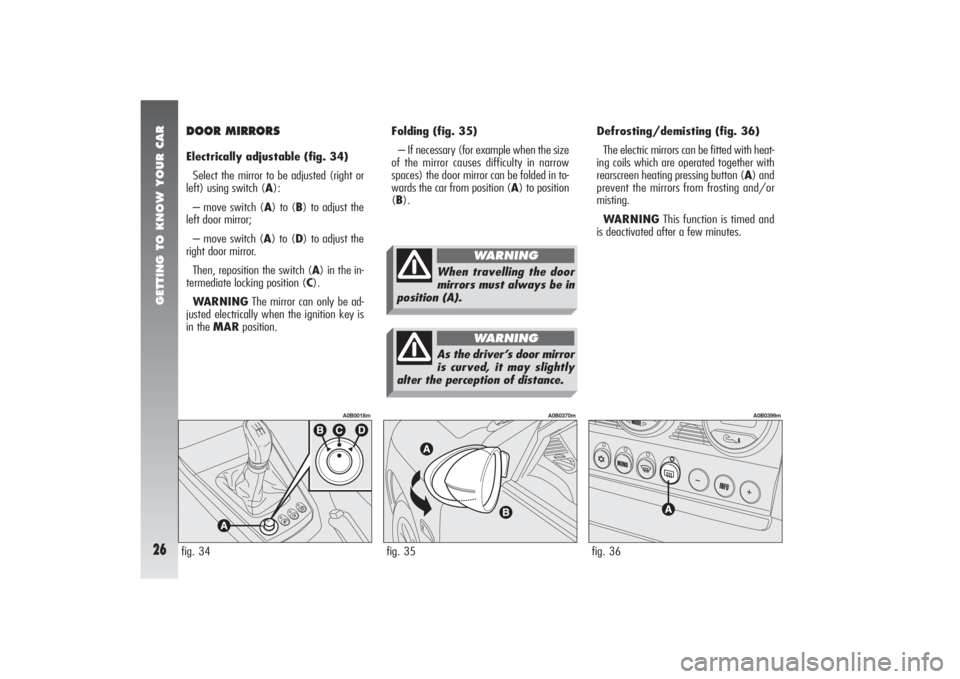
GETTING TO KNOW YOUR CAR26
Folding (fig. 35)
– If necessary (for example when the size
of the mirror causes difficulty in narrow
spaces) the door mirror can be folded in to-
wards the car from position (A) to position
(B).Defrosting/demisting (fig. 36)
The electric mirrors can be fitted with heat-
ing coils which are operated together with
rearscreen heating pressing button (A) and
prevent the mirrors from frosting and/or
misting.
WARNINGThis function is timed and
is deactivated after a few minutes.
fig. 36
A0B0399m
fig. 35
A0B0370m
When travelling the door
mirrors must always be in
position (A).
WARNING
As the driver’s door mirror
is curved, it may slightly
alter the perception of distance.
WARNING
DOOR MIRRORSElectrically adjustable (fig. 34)
Select the mirror to be adjusted (right or
left) using switch (A):
– move switch (A) to (B) to adjust the
left door mirror;
– move switch (A) to (D) to adjust the
right door mirror.
Then, reposition the switch (A) in the in-
termediate locking position (C).
WARNINGThe mirror can only be ad-
justed electrically when the ignition key is
in the MARposition.fig. 34
A0B0018m
Page 37 of 357
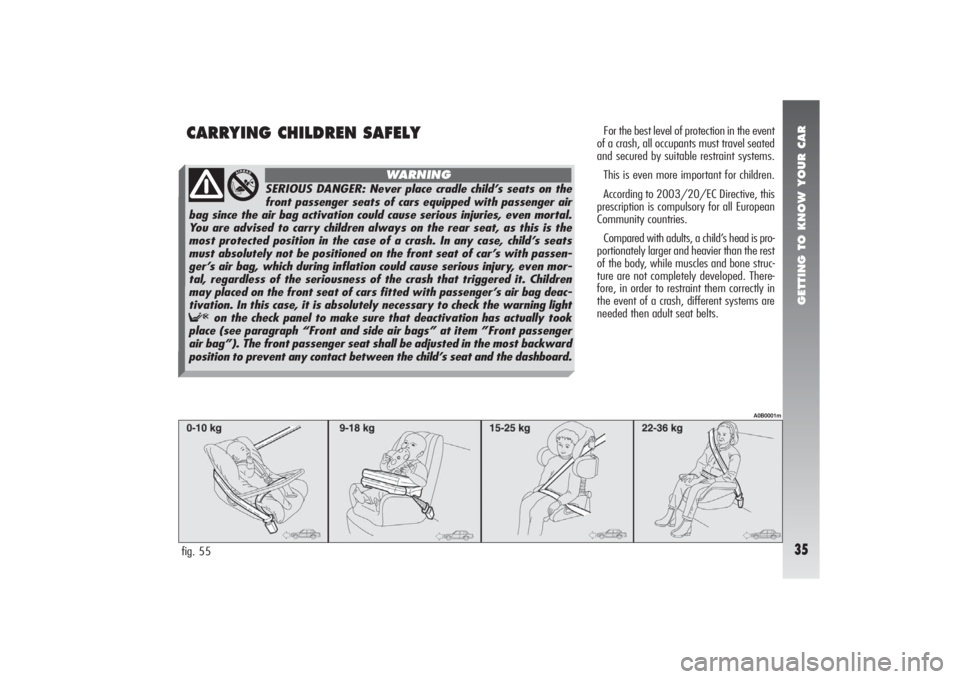
GETTING TO KNOW YOUR CAR35
CARRYING CHILDREN SAFELYfig. 55
A0B0001m
For the best level of protection in the event
of a crash, all occupants must travel seated
and secured by suitable restraint systems.
This is even more important for children.
According to 2003/20/EC Directive, this
prescription is compulsory for all European
Community countries.
Compared with adults, a child’s head is pro-
portionately larger and heavier than the rest
of the body, while muscles and bone struc-
ture are not completely developed. There-
fore, in order to restraint them correctly in
the event of a crash, different systems are
needed then adult seat belts.
SERIOUS DANGER: Never place cradle child’s seats on the
front passenger seats of cars equipped with passenger air
bag since the air bag activation could cause serious injuries, even mortal.
You are advised to carry children always on the rear seat, as this is the
most protected position in the case of a crash. In any case, child’s seats
must absolutely not be positioned on the front seat of car’s with passen-
ger’s air bag, which during inflation could cause serious injury, even mor-
tal, regardless of the seriousness of the crash that triggered it. Children
may placed on the front seat of cars fitted with passenger’s air bag deac-
tivation. In this case, it is absolutely necessary to check the warning light
Fon the check panel to make sure that deactivation has actually took
place (see paragraph “Front and side air bags” at item ”Front passenger
air bag”). The front passenger seat shall be adjusted in the most backward
position to prevent any contact between the child’s seat and the dashboard.
WARNING
Page 41 of 357
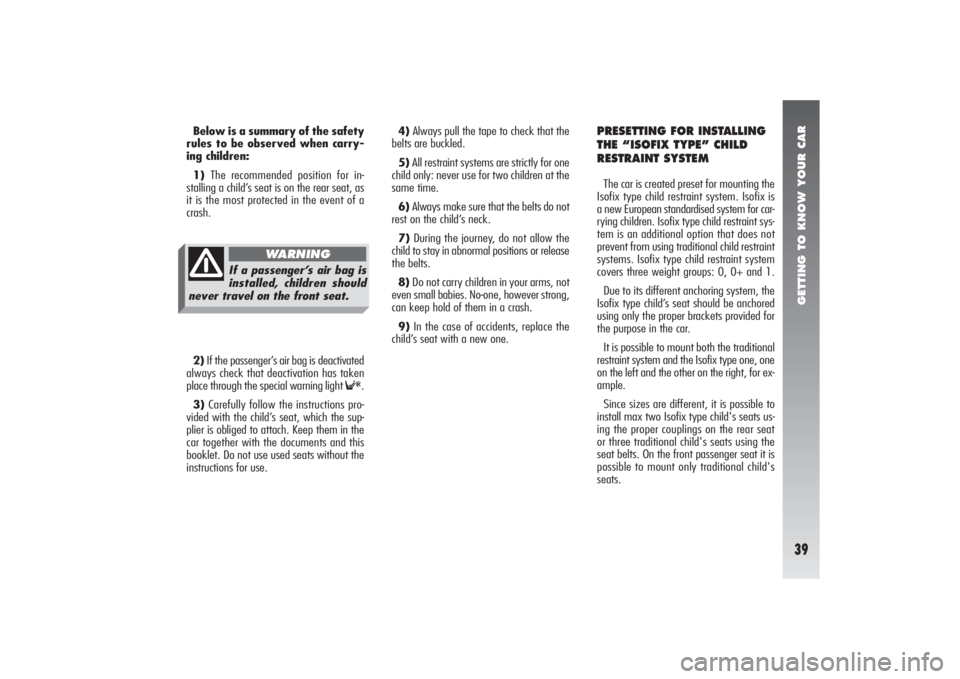
GETTING TO KNOW YOUR CAR39
4)Always pull the tape to check that the
belts are buckled.
5)All restraint systems are strictly for one
child only: never use for two children at the
same time.
6)Always make sure that the belts do not
rest on the child’s neck.
7)During the journey, do not allow the
child to stay in abnormal positions or release
the belts.
8)Do not carry children in your arms, not
even small babies. No-one, however strong,
can keep hold of them in a crash.
9)In the case of accidents, replace the
child’s seat with a new one.
PRESETTING FOR INSTALLING
THE “ISOFIX TYPE” CHILD
RESTRAINT SYSTEMThe car is created preset for mounting the
Isofix type child restraint system. Isofix is
a new European standardised system for car-
rying children. Isofix type child restraint sys-
tem is an additional option that does not
prevent from using traditional child restraint
systems. Isofix type child restraint system
covers three weight groups: 0, 0+ and 1.
Due to its different anchoring system, the
Isofix type child’s seat should be anchored
using only the proper brackets provided for
the purpose in the car.
It is possible to mount both the traditional
restraint system and the Isofix type one, one
on the left and the other on the right, for ex-
ample.
Since sizes are different, it is possible to
install max two Isofix type child's seats us-
ing the proper couplings on the rear seat
or three traditional child's seats using the
seat belts. On the front passenger seat it is
possible to mount only traditional child's
seats. Below is a summary of the safety
rules to be observed when carry-
ing children:
1)The recommended position for in-
stalling a child’s seat is on the rear seat, as
it is the most protected in the event of a
crash.
2)If the passenger’s air bag is deactivated
always check that deactivation has taken
place through the special warning light
F
.
3)Carefully follow the instructions pro-
vided with the child’s seat, which the sup-
plier is obliged to attach. Keep them in the
car together with the documents and this
booklet. Do not use used seats without the
instructions for use.
If a passenger’s air bag is
installed, children should
never travel on the front seat.
WARNING
Page 46 of 357
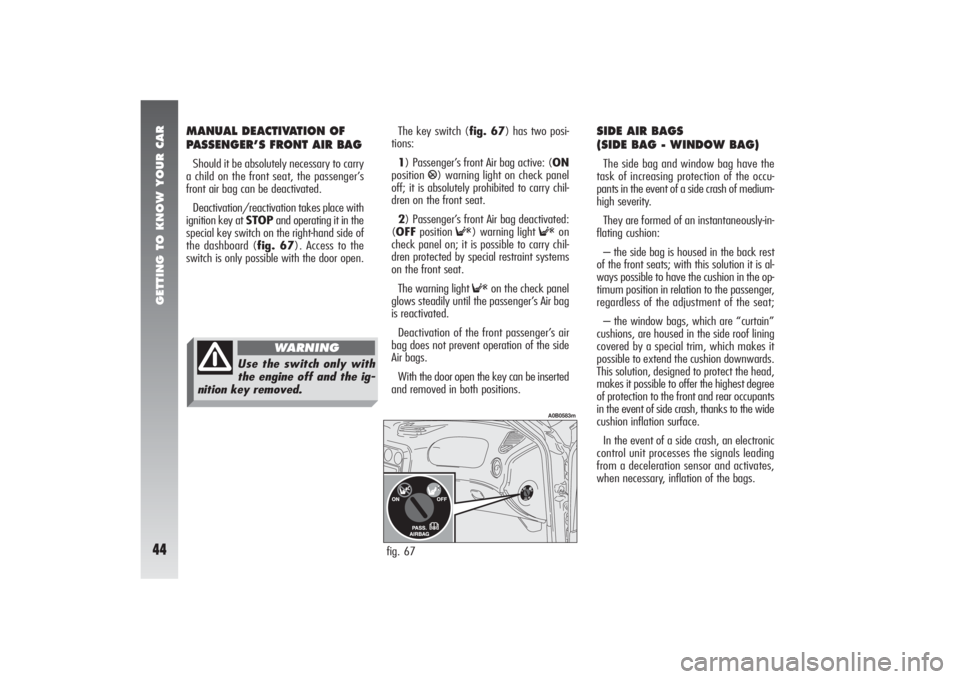
GETTING TO KNOW YOUR CAR44
MANUAL DEACTIVATION OF
PASSENGER’S FRONT AIR BAGShould it be absolutely necessary to carry
a child on the front seat, the passenger’s
front air bag can be deactivated.
Deactivation/reactivation takes place with
ignition key at STOPand operating it in the
special key switch on the right-hand side of
the dashboard (fig. 67). Access to the
switch is only possible with the door open.The key switch (fig. 67) has two posi-
tions:
1) Passenger’s front Air bag active: (ON
position
P) warning light on check panel
off; it is absolutely prohibited to carry chil-
dren on the front seat.
2) Passenger’s front Air bag deactivated:
(OFFposition
F
) warning light
F
on
check panel on; it is possible to carry chil-
dren protected by special restraint systems
on the front seat.
The warning light
F
on the check panel
glows steadily until the passenger’s Air bag
is reactivated.
Deactivation of the front passenger’s air
bag does not prevent operation of the side
Air bags.
With the door open the key can be inserted
and removed in both positions.
SIDE AIR BAGS
(SIDE BAG - WINDOW BAG)The side bag and window bag have the
task of increasing protection of the occu-
pants in the event of a side crash of medium-
high severity.
They are formed of an instantaneously-in-
flating cushion:
– the side bag is housed in the back rest
of the front seats; with this solution it is al-
ways possible to have the cushion in the op-
timum position in relation to the passenger,
regardless of the adjustment of the seat;
– the window bags, which are “curtain”
cushions, are housed in the side roof lining
covered by a special trim, which makes it
possible to extend the cushion downwards.
This solution, designed to protect the head,
makes it possible to offer the highest degree
of protection to the front and rear occupants
in the event of side crash, thanks to the wide
cushion inflation surface.
In the event of a side crash, an electronic
control unit processes the signals leading
from a deceleration sensor and activates,
when necessary, inflation of the bags.
fig. 67
A0B0583m
Use the switch only with
the engine off and the ig-
nition key removed.
WARNING
Page 48 of 357
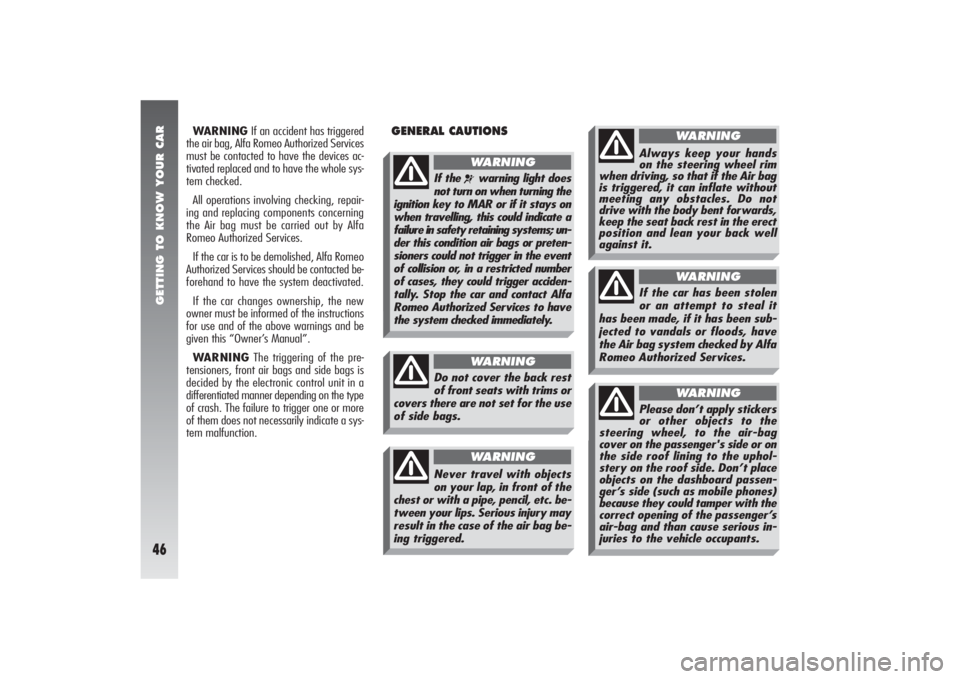
GETTING TO KNOW YOUR CAR46
WARNINGIf an accident has triggered
the air bag, Alfa Romeo Authorized Services
must be contacted to have the devices ac-
tivated replaced and to have the whole sys-
tem checked.
All operations involving checking, repair-
ing and replacing components concerning
the Air bag must be carried out by Alfa
Romeo Authorized Services.
If the car is to be demolished, Alfa Romeo
Authorized Services should be contacted be-
forehand to have the system deactivated.
If the car changes ownership, the new
owner must be informed of the instructions
for use and of the above warnings and be
given this “Owner’s Manual”.
WARNINGThe triggering of the pre-
tensioners, front air bags and side bags is
decided by the electronic control unit in a
differentiated manner depending on the type
of crash. The failure to trigger one or more
of them does not necessarily indicate a sys-
tem malfunction.
GENERAL CAUTIONS
If the
¬
warning light does
not turn on when turning the
ignition key to MAR or if it stays on
when travelling, this could indicate a
failure in safety retaining systems; un-
der this condition air bags or preten-
sioners could not trigger in the event
of collision or, in a restricted number
of cases, they could trigger acciden-
tally. Stop the car and contact Alfa
Romeo Authorized Services to have
the system checked immediately.WARNING
Do not cover the back rest
of front seats with trims or
covers there are not set for the use
of side bags.
WARNING
Never travel with objects
on your lap, in front of the
chest or with a pipe, pencil, etc. be-
tween your lips. Serious injury may
result in the case of the air bag be-
ing triggered.
WARNING
Always keep your hands
on the steering wheel rim
when driving, so that if the Air bag
is triggered, it can inflate without
meeting any obstacles. Do not
drive with the body bent forwards,
keep the seat back rest in the erect
position and lean your back well
against it.
WARNING
If the car has been stolen
or an attempt to steal it
has been made, if it has been sub-
jected to vandals or floods, have
the Air bag system checked by Alfa
Romeo Authorized Services.
WARNING
Please don’t apply stickers
or other objects to the
steering wheel, to the air-bag
cover on the passenger's side or on
the side roof lining to the uphol-
stery on the roof side. Don’t place
objects on the dashboard passen-
ger’s side (such as mobile phones)
because they could tamper with the
correct opening of the passenger’s
air-bag and than cause serious in-
juries to the vehicle occupants.
WARNING
Page 49 of 357
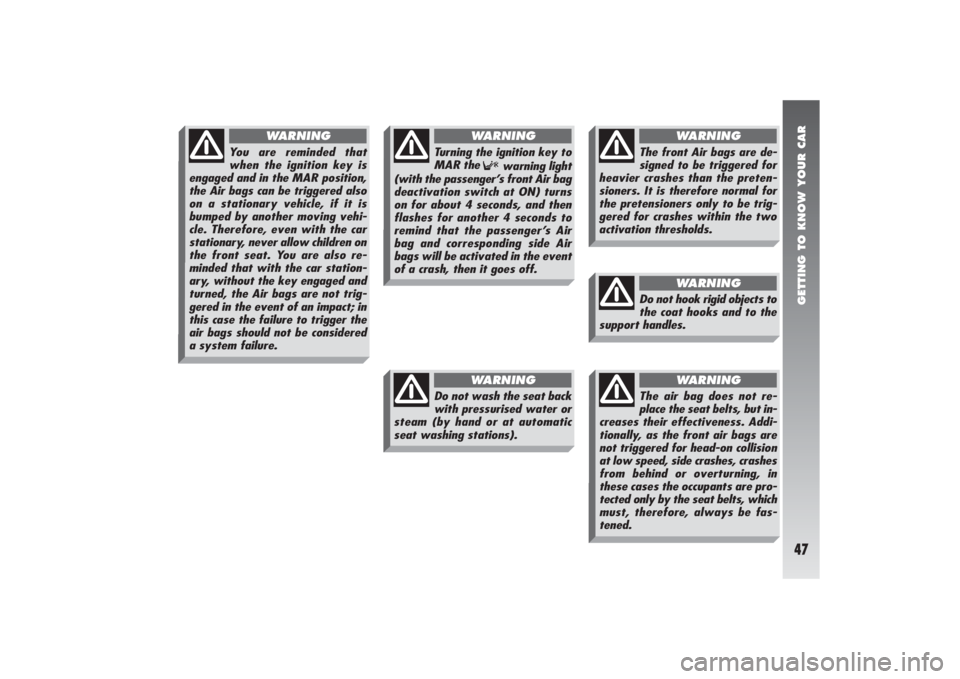
GETTING TO KNOW YOUR CAR47
You are reminded that
when the ignition key is
engaged and in the MAR position,
the Air bags can be triggered also
on a stationary vehicle, if it is
bumped by another moving vehi-
cle. Therefore, even with the car
stationary, never allow children on
the front seat. You are also re-
minded that with the car station-
ary, without the key engaged and
turned, the Air bags are not trig-
gered in the event of an impact; in
this case the failure to trigger the
air bags should not be considered
a system failure.
WARNING
Turning the ignition key to
MAR the
F
warning light
(with the passenger’s front Air bag
deactivation switch at ON) turns
on for about 4 seconds, and then
flashes for another 4 seconds to
remind that the passenger’s Air
bag and corresponding side Air
bags will be activated in the event
of a crash, then it goes off.
WARNING
Do not wash the seat back
with pressurised water or
steam (by hand or at automatic
seat washing stations).
WARNING
The front Air bags are de-
signed to be triggered for
heavier crashes than the preten-
sioners. It is therefore normal for
the pretensioners only to be trig-
gered for crashes within the two
activation thresholds.
WARNING
Do not hook rigid objects to
the coat hooks and to the
support handles.
WARNING
The air bag does not re-
place the seat belts, but in-
creases their effectiveness. Addi-
tionally, as the front air bags are
not triggered for head-on collision
at low speed, side crashes, crashes
from behind or overturning, in
these cases the occupants are pro-
tected only by the seat belts, which
must, therefore, always be fas-
tened.
WARNING
Page 50 of 357
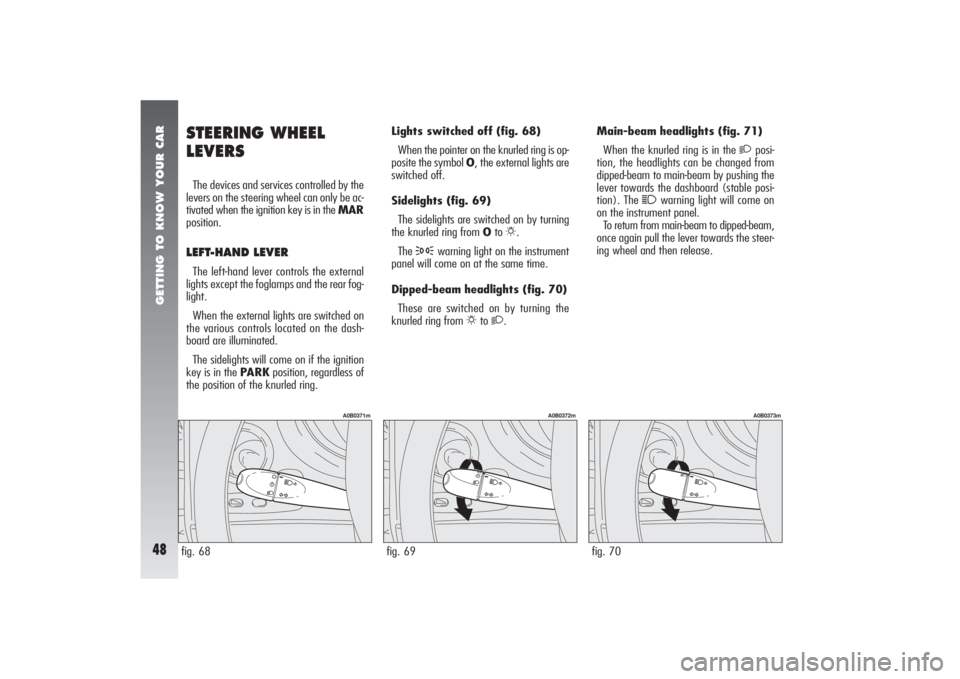
GETTING TO KNOW YOUR CAR48
fig. 70
A0B0373m
STEERING WHEEL
LEVERSThe devices and services controlled by the
levers on the steering wheel can only be ac-
tivated when the ignition key is in the MAR
position.LEFT-HAND LEVERThe left-hand lever controls the external
lights except the foglamps and the rear fog-
light.
When the external lights are switched on
the various controls located on the dash-
board are illuminated.
The sidelights will come on if the ignition
key is in the PARKposition, regardless of
the position of the knurled ring.Lights switched off (fig. 68)
When the pointer on the knurled ring is op-
posite the symbol O, the external lights are
switched off.
Sidelights (fig. 69)
The sidelights are switched on by turning
the knurled ring from Oto
6.
The
3
warning light on the instrument
panel will come on at the same time.
Dipped-beam headlights (fig. 70)
These are switched on by turning the
knurled ring from
6
to 2
.Main-beam headlights (fig. 71)
When the knurled ring is in the
2
posi-
tion, the headlights can be changed from
dipped-beam to main-beam by pushing the
lever towards the dashboard (stable posi-
tion). The
1
warning light will come on
on the instrument panel.
To return from main-beam to dipped-beam,
once again pull the lever towards the steer-
ing wheel and then release.
fig. 68
A0B0371m
fig. 69
A0B0372m
Page 51 of 357
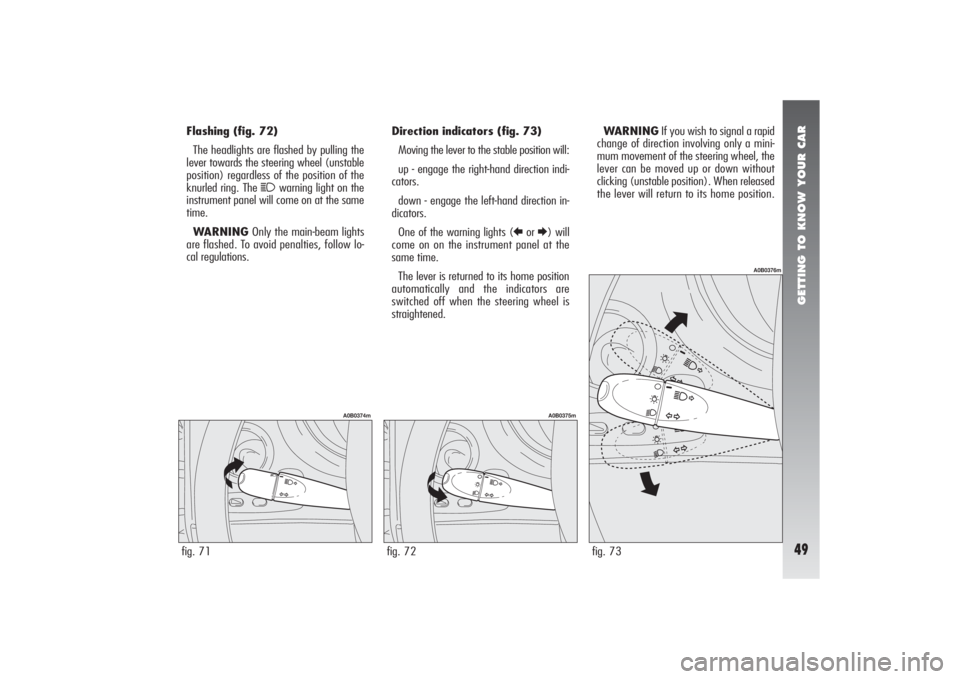
GETTING TO KNOW YOUR CAR49
Flashing (fig. 72)
The headlights are flashed by pulling the
lever towards the steering wheel (unstable
position) regardless of the position of the
knurled ring. The
1
warning light on the
instrument panel will come on at the same
time.
WARNINGOnly the main-beam lights
are flashed. To avoid penalties, follow lo-
cal regulations.Direction indicators (fig. 73)
Moving the lever to the stable position will:
up - engage the right-hand direction indi-
cators.
down - engage the left-hand direction in-
dicators.
One of the warning lights (
R
or
E) will
come on on the instrument panel at the
same time.
The lever is returned to its home position
automatically and the indicators are
switched off when the steering wheel is
straightened.WARNINGIf you wish to signal a rapid
change of direction involving only a mini-
mum movement of the steering wheel, the
lever can be moved up or down without
clicking (unstable position). When released
the lever will return to its home position.
fig. 73
A0B0376m
fig. 71
A0B0374m
fig. 72
A0B0375m
Page 54 of 357
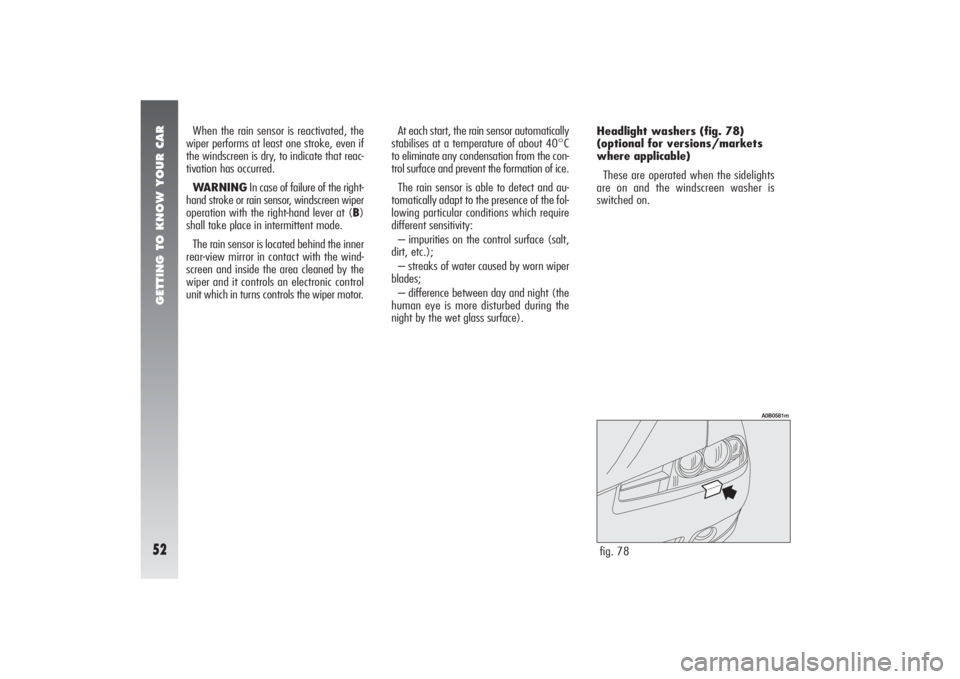
GETTING TO KNOW YOUR CAR52
When the rain sensor is reactivated, the
wiper performs at least one stroke, even if
the windscreen is dry, to indicate that reac-
tivation has occurred.
WARNINGIn case of failure of the right-
hand stroke or rain sensor, windscreen wiper
operation with the right-hand lever at (B)
shall take place in intermittent mode.
The rain sensor is located behind the inner
rear-view mirror in contact with the wind-
screen and inside the area cleaned by the
wiper and it controls an electronic control
unit which in turns controls the wiper motor.At each start, the rain sensor automatically
stabilises at a temperature of about 40°C
to eliminate any condensation from the con-
trol surface and prevent the formation of ice.
The rain sensor is able to detect and au-
tomatically adapt to the presence of the fol-
lowing particular conditions which require
different sensitivity:
– impurities on the control surface (salt,
dirt, etc.);
– streaks of water caused by worn wiper
blades;
– difference between day and night (the
human eye is more disturbed during the
night by the wet glass surface).Headlight washers (fig. 78)
(optional for versions/markets
where applicable)
These are operated when the sidelights
are on and the windscreen washer is
switched on.
fig. 78
A0B0581m
Page 55 of 357
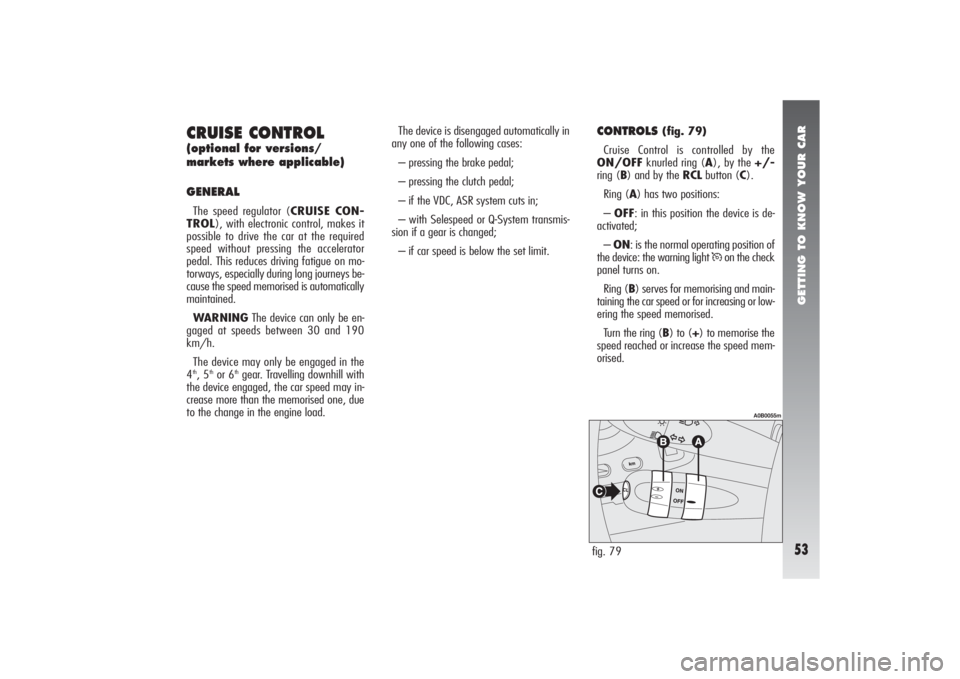
GETTING TO KNOW YOUR CAR53
CRUISE CONTROL(optional for versions/
markets where applicable)
GENERALThe speed regulator (CRUISE CON-
TROL), with electronic control, makes it
possible to drive the car at the required
speed without pressing the accelerator
pedal. This reduces driving fatigue on mo-
torways, especially during long journeys be-
cause the speed memorised is automatically
maintained.
WARNINGThe device can only be en-
gaged at speeds between 30 and 190
km/h.
The device may only be engaged in the
4th, 5
thor 6
thgear. Travelling downhill with
the device engaged, the car speed may in-
crease more than the memorised one, due
to the change in the engine load.The device is disengaged automatically in
any one of the following cases:
– pressing the brake pedal;
– pressing the clutch pedal;
– if the VDC, ASR system cuts in;
– with Selespeed or Q-System transmis-
sion if a gear is changed;
– if car speed is below the set limit.
CONTROLS
(fig. 79)
Cruise Control is controlled by the
ON/OFFknurled ring (A), by the +/-
ring (B) and by the RCLbutton (C).
Ring (A) has two positions:
– OFF: in this position the device is de-
activated;
– ON: is the normal operating position of
the device: the warning light
Ü
on the check
panel turns on.
Ring (B) serves for memorising and main-
taining the car speed or for increasing or low-
ering the speed memorised.
Turn the ring (B) to (+) to memorise the
speed reached or increase the speed mem-
orised.
fig. 79
A0B0055m